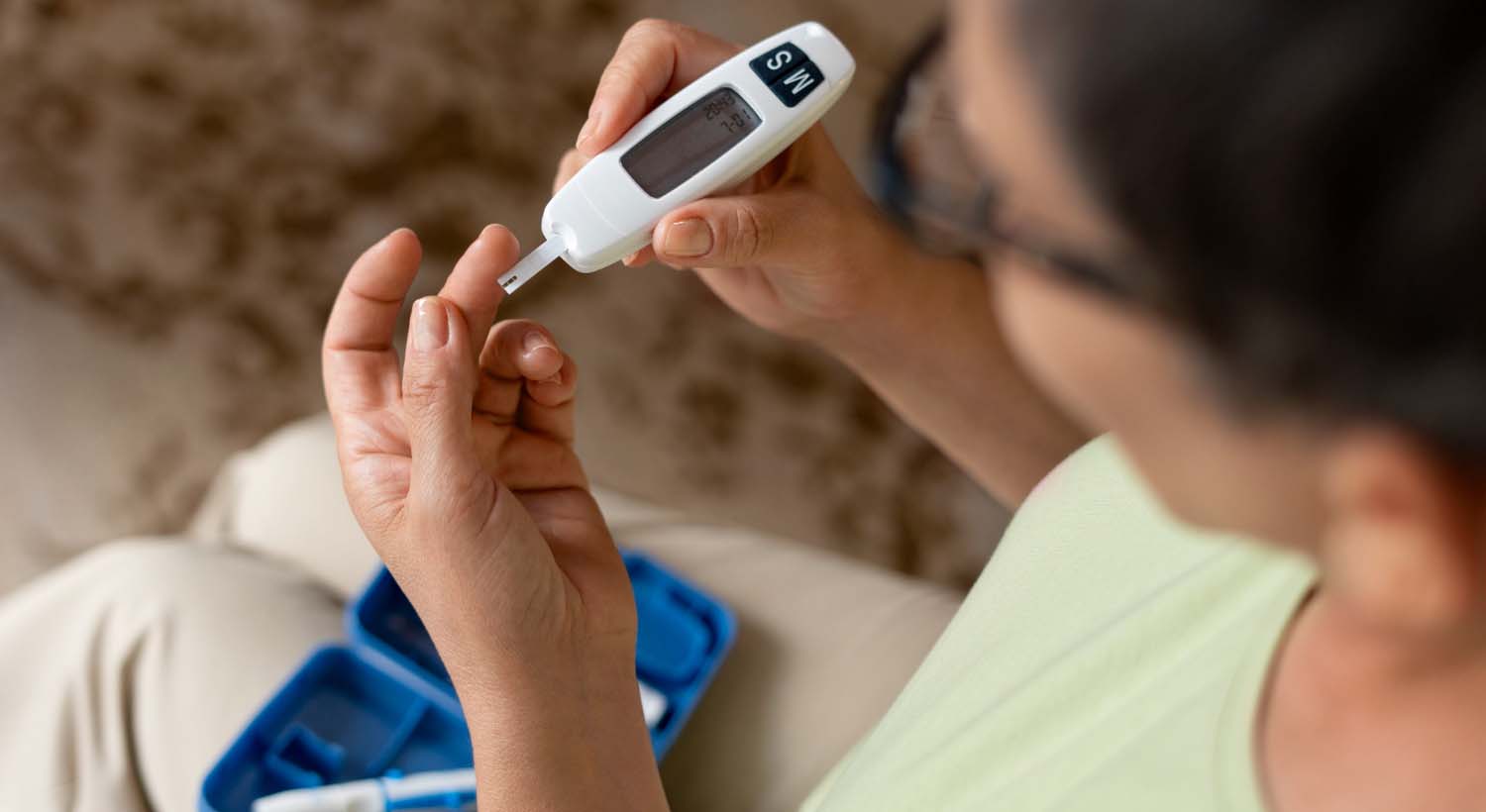Welcome to our comprehensive guide on Type 2 Diabetes. In this article, we will provide you with valuable insights into the prevention and management of this condition. Type 2 Diabetes is a chronic health condition that affects millions of people worldwide. It is a condition where the body is unable to process glucose effectively, leading to high levels of sugar in the blood.
In this guide, we will cover everything you need to know about Type 2 Diabetes, from its causes and symptoms to its management and prevention strategies. We will explore how lifestyle modifications and medications can help individuals control their blood sugar levels and manage the complications associated with this condition.
Our goal is to empower readers to take control of their health and live well with Type 2 Diabetes. So let’s dive into the world of Type 2 Diabetes, gain a deeper understanding of this condition, and discover proven strategies to enhance your quality of life.
Key Takeaways
- Type 2 Diabetes is a chronic health condition that affects millions of people worldwide.
- The condition causes high levels of sugar in the blood, which can lead to complications if not managed properly.
- In this article, we will explore the various aspects of prevention and management of Type 2 Diabetes.
- We will cover lifestyle modifications, medications, and monitoring blood sugar levels to help manage this condition effectively.
- Our aim is to empower readers to take control of their health and live well with Type 2 Diabetes.
What is Type 2 Diabetes?
If you or someone you know has been diagnosed with Type 2 Diabetes, it is essential to understand what this condition entails. Type 2 Diabetes is a chronic disease that affects how your body processes blood sugar, also known as glucose. Glucose is a vital source of energy for your body, and insulin, a hormone produced by the pancreas, is responsible for allowing glucose to enter the cells and be used for energy.
In the case of Type 2 Diabetes, your body either becomes resistant to insulin or does not produce enough insulin to regulate blood sugar effectively. As a result, glucose accumulates in your bloodstream, leading to high blood sugar levels that can cause long-term health complications if left untreated.
Causes of Type 2 Diabetes
The exact causes of Type 2 Diabetes are not fully understood, but several factors can increase your risk of developing this condition. These risk factors include:
- Being overweight or obese
- Lack of physical activity
- Unhealthy diet
- Family history of diabetes
- Age (risk increases with age)
- High blood pressure
- High cholesterol levels
- Polycystic ovary syndrome (PCOS)
- History of gestational diabetes
If you have any of these risk factors, it is crucial to maintain a healthy lifestyle and monitor your blood sugar levels regularly. Early detection and management of Type 2 Diabetes can prevent or delay complications and improve your overall quality of life.
Diagnosing Type 2 Diabetes
Diagnosing Type 2 Diabetes is critical to managing this condition effectively. The diagnostic process involves various tests and measurements to determine an individual’s blood sugar levels. The most common tests include fasting plasma glucose, oral glucose tolerance, and glycated haemoglobin. If any of these tests reveal high blood sugar levels, further testing may be required to confirm the diagnosis.
It’s important to note that early detection of Type 2 Diabetes is crucial to prevent complications that can arise from prolonged exposure to high blood sugar levels. Therefore, it’s recommended that individuals at high risk of developing Type 2 Diabetes undergo regular screening tests, including those with a family history of the condition, those with a sedentary lifestyle, and those who are overweight or obese.
Measuring Blood Sugar Levels
Self-monitoring of blood sugar levels is an essential component of Type 2 Diabetes management. This involves using a blood glucose meter to measure blood sugar levels regularly. This helps individuals track their levels and adjust their diet, exercise, and medication accordingly to maintain optimal blood sugar levels.
Another method of monitoring blood sugar levels is through continuous glucose monitoring systems. These devices provide real-time data on blood sugar levels and help individuals identify fluctuations in their levels throughout the day. This information can be used to adjust diet, exercise, and medication to prevent complications associated with high or low blood sugar levels.
Complications of Undiagnosed or Untreated Type 2 Diabetes
Undiagnosed or untreated Type 2 Diabetes can lead to serious complications, including cardiovascular diseases, kidney problems, nerve damage, and eye-related issues. Regular screening tests and early detection can help prevent these complications from arising.
“Early diagnosis and treatment can save lives,” says the American Diabetes Association. “It can lower the risk of other health problems that can develop over time. It is important to talk to your healthcare provider if you have concerns about Type 2 Diabetes or believe you may be at risk.”
If you have any concerns or experience any symptoms of Type 2 Diabetes, such as increased thirst and urination, blurred vision, fatigue, and slow-healing wounds, speak to your healthcare provider immediately. Early detection and treatment can help you manage your condition effectively and prevent complications.
Prevention Strategies for Type 2 Diabetes

Prevention is key in managing Type 2 Diabetes. Lifestyle modifications play a critical role in reducing the risk of developing this condition. Here are some strategies that can help:
- Healthy diet: A diet rich in whole grains, fruits, vegetables, lean protein, and healthy fats can help regulate blood sugar levels and reduce the risk of diabetes. Avoiding processed foods and sugary drinks is also important.
- Regular physical activity: Exercise can help reduce insulin resistance, which is a risk factor for Type 2 Diabetes. Try to engage in moderate-intensity exercise for at least 30 minutes a day.
- Weight management: Maintaining a healthy weight can help prevent Type 2 Diabetes. Losing even a small amount of weight can have significant health benefits, including reducing the risk of this condition.
- Stress reduction: Chronic stress can increase blood sugar levels and contribute to the development of Type 2 Diabetes. Finding ways to manage stress, such as through meditation or yoga, can help reduce this risk.
- Regular health check-ups: Regular health check-ups can help detect the early signs of Type 2 Diabetes and other health conditions. Speak to your healthcare provider about your risk factors and how often you should get tested.
Implementing these prevention strategies can help reduce your risk of developing Type 2 Diabetes. It is never too early or too late to make positive changes to your lifestyle. Small changes can make a big difference in your overall health and well-being.
Managing Type 2 Diabetes through Lifestyle Changes
Managing Type 2 Diabetes can be challenging, but with the right lifestyle changes, it can be possible to keep it under control. Embracing a healthier way of living is crucial to achieving the best possible outcomes.
Importance of a Healthy Diet
Eating a well-balanced diet is essential when it comes to managing Type 2 Diabetes. Foods that contain high levels of fat, sugar, and carbohydrates should be avoided, as they can cause blood sugar levels to spike. Instead, opt for a diet that includes a variety of fruits, vegetables, whole grains, and lean protein sources.
Regular Physical Activity
Physical activity is an effective way to manage Type 2 Diabetes. It can help to lower blood sugar levels, improve insulin sensitivity, and reduce the risk of developing other health problems. Aim to incorporate at least 30 minutes of moderate exercise into your daily routine.
Weight Management
Being overweight or obese increases the risk of developing Type 2 Diabetes. Effective weight management is crucial to managing this condition. Adopting a healthy diet and engaging in regular physical activity are effective ways to maintain a healthy weight.
Stress Reduction
Stress can have a negative impact on blood sugar levels. Engaging in stress-reducing activities, such as meditation or yoga, can help to manage stress and keep blood sugar levels under control.
The Significance of Getting Enough Sleep
Adequate sleep is essential for overall health and well-being. It also plays a crucial role in managing Type 2 Diabetes. Lack of sleep can cause insulin resistance, which can lead to elevated blood sugar levels. Aim to get at least 7-8 hours of sleep each night.
Medications for Type 2 Diabetes Management
When it comes to managing Type 2 Diabetes, medications can play a crucial role in controlling blood sugar levels. There are various medications available for Type 2 Diabetes management, including oral medications, injectable therapies, and insulin.
Oral Medications
Oral medications are often prescribed as a first-line treatment for Type 2 Diabetes. These medications work by either helping the body produce more insulin or by making the body more sensitive to the insulin it already produces. Some common types of oral medications for Type 2 Diabetes management include:
| Type of Medication | How it Works |
|---|---|
| Metformin | Decreases glucose production in the liver and improves insulin sensitivity |
| Sulfonylureas | Stimulates the pancreas to release insulin |
| DPP-4 inhibitors | Increases insulin production in response to meals and decreases glucose production |
Injectable Therapies
Injectable therapies are another option for managing Type 2 Diabetes. These medications are delivered via injection and help the body produce or use insulin more effectively. Some common types of injectable therapies include:
- GLP-1 receptor agonists: Stimulates insulin production and slows digestion, resulting in lower blood sugar levels
- SGLT2 inhibitors: Prevents glucose reabsorption in the kidneys, leading to increased glucose excretion and lower blood sugar levels
Insulin
Insulin is a hormone that regulates blood sugar levels in the body. For people with Type 2 Diabetes who cannot control their blood sugar levels through diet and exercise alone, insulin therapy may be necessary. There are various types of insulin available, including fast-acting, long-acting, and combination insulins. Your healthcare provider can help determine the most appropriate insulin regimen for you.
It is important to note that medications should always be taken under the guidance of a healthcare provider and as prescribed. Overuse or misuse of these medications can lead to serious complications. Your healthcare provider can help you understand the potential side effects and risks associated with each type of medication.
Monitoring Blood Sugar Levels for Effective Type 2 Diabetes Management

Monitoring blood sugar levels is essential for effective management of Type 2 Diabetes. It involves regularly checking and tracking blood glucose levels to maintain a healthy range and prevent complications. There are several methods and tools available for monitoring blood sugar levels, each with its advantages and disadvantages.
Self-Monitoring Blood Glucose (SMBG)
SMBG is a common method used to monitor blood sugar levels at home. This method involves using a blood glucose meter to measure blood sugar levels by pricking the finger and placing a drop of blood on a test strip. The meter then displays the blood glucose level within seconds. SMBG is a simple, convenient, and cost-effective method, allowing individuals to monitor their blood sugar levels regularly and adjust their medication, diet, and physical activity accordingly.
Continuous Glucose Monitoring (CGM)
CGM is a relatively new method that involves using a small sensor placed under the skin to monitor blood glucose levels continuously. The sensor records glucose levels every few minutes, and the data is transmitted wirelessly to a receiver or smartphone app. CGM provides real-time data, allowing individuals with Type 2 Diabetes to make immediate adjustments to their medication, diet, and physical activity to keep their blood sugar levels within a healthy range. CGM is particularly useful for those who experience frequent hypoglycaemia or hyperglycaemia episodes.
HbA1c Test
The HbA1c test measures the average blood glucose levels over the past two to three months. It is an essential test to monitor long-term blood sugar control and assess the effectiveness of diabetes management. The HbA1c test is usually performed by a healthcare professional and involves a blood sample taken from the arm. The test measures the percentage of haemoglobin in the blood that has glucose attached to it (glycated haemoglobin). The higher the HbA1c level, the greater the risk of developing complications associated with Type 2 Diabetes.
Monitoring blood sugar levels regularly is crucial for effective management of Type 2 Diabetes. It helps individuals understand how different factors affect their blood glucose levels and take appropriate action to keep their levels within a healthy range. By working closely with healthcare professionals and using the right monitoring method and tool, individuals with Type 2 Diabetes can lead a healthy and fulfilling life.
Managing Complications Associated with Type 2 Diabetes
Living with Type 2 Diabetes can lead to potential complications that affect various parts of the body. Below is a summary of common complications associated with this condition and ways to manage them effectively.
Cardiovascular Diseases
People with Type 2 Diabetes are at an increased risk of developing cardiovascular diseases, including heart attacks and strokes. Management strategies include:
- Controlling blood pressure and cholesterol levels through medication and lifestyle modifications.
- Following a heart-healthy diet and engaging in regular physical activity.
- Quitting smoking.
Nerve Damage (Neuropathy)
Diabetic neuropathy can cause numbness, tingling, and pain in the feet and hands. Management strategies include:
- Monitoring blood sugar levels closely to prevent nerve damage.
- Wearing comfortable and properly fitting shoes to prevent foot injuries.
- Inspecting feet daily to detect any signs of infection or injury and seeking prompt medical attention if needed.
Kidney Problems (Nephropathy)
Type 2 Diabetes can also lead to kidney problems and, in severe cases, kidney failure. Management strategies include:
- Controlling blood pressure and blood sugar levels through medication and lifestyle modifications.
- Monitoring kidney function through regular blood and urine tests.
- Limiting salt and protein intake in the diet.
Eye-related Issues
Diabetic retinopathy is an eye-related complication that can cause vision loss and blindness. Management strategies include:
- Having regular eye exams to detect any signs of retinopathy.
- Controlling blood sugar and blood pressure levels to reduce the risk of developing retinopathy.
- Seeking prompt medical attention if there are any changes in vision.
By staying proactive in managing Type 2 Diabetes and its associated complications, individuals can live well with this condition. Staying informed, taking prescribed medications, and following recommended lifestyle modifications can help prevent or delay complications and enhance overall quality of life.
Emotional Well-being and Support
Living with Type 2 Diabetes can be emotionally challenging, and seeking support is crucial for maintaining good mental health.
Emotional well-being plays a significant role in managing diabetes, and there are various ways to enhance it. Talking to a mental health professional, joining a support group, and practicing mindfulness and relaxation techniques are just a few examples of activities that can be beneficial.
Family and friends also play an essential role in providing emotional support. They can offer encouragement, help with self-care, and assist with daily tasks.
In addition to emotional support, it is equally important to seek help in managing the practical aspects of diabetes. This may include seeking guidance from a healthcare professional on proper medication use, learning how to monitor blood sugar levels, and adjusting lifestyle habits to improve diabetes management.
“The emotional aspect of diabetes is just as important as the physical. It’s essential to take care of our emotional well-being along with managing the condition itself.” – John, a person living with Type 2 Diabetes.
Remember that each person’s journey with diabetes is unique, and seeking personalized support can be helpful for managing the physical and emotional aspects of the condition. Don’t hesitate to reach out for help when needed.
Conclusion
Managing and preventing Type 2 Diabetes requires a combination of early detection, healthy lifestyle modifications, and monitoring of blood sugar levels. Regular exercise, a balanced diet, and stress management can all contribute to reducing the risk of developing this condition.
It is important to work closely with healthcare professionals and seek support from friends and family to manage the emotional impact of living with Type 2 Diabetes. With the right strategies and tools, individuals can effectively manage this condition and improve their overall quality of life.
Remember, prevention and early detection are crucial for managing Type 2 Diabetes effectively. By taking proactive steps and making positive lifestyle changes, individuals can reduce their risk of complications and achieve optimal health and well-being.
FAQ
What is Type 2 Diabetes?
Type 2 Diabetes is a chronic condition characterized by high blood sugar levels resulting from the body’s inability to effectively use insulin.
How is Type 2 Diabetes diagnosed?
Type 2 Diabetes is diagnosed through various tests, including fasting blood glucose tests, oral glucose tolerance tests, and A1C tests.
What are the risk factors for Type 2 Diabetes?
Risk factors for Type 2 Diabetes include being overweight or obese, having a family history of diabetes, leading a sedentary lifestyle, and having high blood pressure or high cholesterol levels.
Can Type 2 Diabetes be prevented?
Yes, Type 2 Diabetes can often be prevented or delayed through lifestyle changes, such as adopting a healthy diet, engaging in regular physical activity, and maintaining a healthy weight.
What are the treatment options for managing Type 2 Diabetes?
Treatment options for managing Type 2 Diabetes include lifestyle modifications (diet and exercise), oral medications, injectable therapies, and insulin.
How often should blood sugar levels be monitored?
The frequency of blood sugar monitoring varies depending on individual circumstances. It is typically recommended to monitor blood sugar levels regularly, as advised by healthcare professionals.
What are the potential complications of Type 2 Diabetes?
Type 2 Diabetes can lead to various complications, including cardiovascular diseases, nerve damage, kidney problems, and eye-related issues.
How can emotional well-being be supported for individuals with Type 2 Diabetes?
Emotional well-being can be supported through seeking support from healthcare professionals, friends, and family, as well as utilizing coping strategies such as stress reduction techniques and maintaining a positive mindset.



Understanding Type 2 Diabetes: Prevention and Management Guide